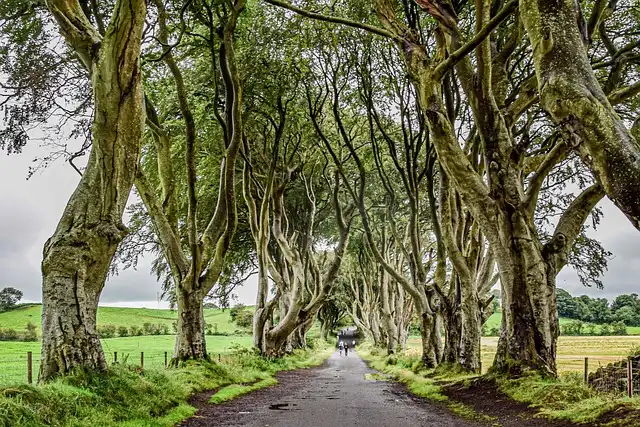House of Guinness: Filming Locations & Production Secrets

Discover the filming locations of 'House of Guinness,' including Liverpool, Manchester, and Welsh castles. The series recreated 1860s Dublin in England due to Dublin's modern changes. Explore production design secrets!
Filming additionally occurred in the period-appropriate streets of the north-west’s other terrific city. Manchester’s Northern Quarter took the place of New york city’s Bowery location, with Byron Hedges (Jack Gleeson of Video Game of Thrones) being chased after along Dale Road, Paton Street, China Lane and Back Piccadilly in episode 4.
Manchester’s Role: Northern Quarter
Episode four presents us to yet another elegant Guinness residence: St Anne’s. This estate, home to Arthur and his other half Olivia, was built in 1837 by Benjamin Guinness in a substantial private park to the north of Dublin; sold to the city in 1939, it was eventually demolished in 1968 after a fire.
It arises early in the collection that the three inheriting Guinnesses do not understand all of their family members properties, consisting of Ashford Castle. Situated in Cong, Region Mayo, this was an additional purchase by their father Benjamin, and it stayed in the family up until it was marketed with much of their property in 1939.
Guinness Family Properties Explored
The castle we see in episode 3, when Anne visits, remains in truth Penrhyn Castle near Bangor in Wales. It was mostly constructed in a sensational Norman style, complete with a cathedral-like curved entryway hall, by engineer Thomas Receptacle in the early 19th century, on the website of a much-adapted 15th-century strengthened estate residence, and is one of the largest castles in Britain. Previously the home of the Pennant family, who made their fortune in slate and sugar vineyards, it was handed to the National Rely on 1951, and it is open to visitors.
Much of the activity in Residence of Guinness is embeded in the family’s Dublin manor, Iveagh Residence. Acquired in 1862 by Benjamin Guinness, this was initially two houses, built in the mid-18th century, sitting on St Stephen’s Green in the centre of Dublin. Since 1939, it has been the home of the Irish Department of Foreign Matters.
Dublin Manor: Iveagh House
Along with Stanley Dock and Croxteth Hall, Liverpool provided various other locations. St George’s Hall, the fantastic public building in the centre of the city, acted as the background to big gatherings, consisting of the trouble in episode one and the presentation in episode three.
Liverpool’s Historic Locations
For scenes at St Anne’s, the production filmed at Broughton Hall, the Georgian estate of the Tempest family members in Skipton, founded in the 14th century but redesigned at the end of the 18th century. Filming occurred throughout, consisting of sights of the lengthy sunroom and your house’s famed gardens. Included in television’s Gent Jack, the remake of All Creatures Small and excellent and in the 1992 film of Wuthering Heights, those seeking a preference of the Guinness life will certainly find it’s now available for rental as a holiday location or company resort.
For the exterior of Iveagh Home, the manufacturing used Croxteth Hall in Liverpool. Positioned in the west of the city, this was the home of the Molyneux family from the 16th century yet was mostly restored at the start of the 18th century. To match the actual Iveagh, the Hall was transformed with a little cgi and a brand-new entry information, while likewise furnishing numerous other locations, from the bed room in the Hope Street residence where Arthur hides out to the Tavern where we see the republican Patrick Cochrane.
It’s most certainly a Dublin story, Home of Guinness didn’t movie in Dublin at all. While the real-life Guinness Brewery and the household’s home Iveagh House are still standing, they are now active places of work, and it was less complicated to recreate them in the historical components of Liverpool and Manchester. In certain, Home of Guinness made use of a substantial previous cigarette stockroom, which enabled them to recreate every little thing, from the manufacturing facility flooring to workplaces and outdoor areas, such as the cooperage and roads, all in one location. Much of the action in House of Guinness is established in the household’s Dublin estate, Iveagh House. Bought in 1862 by Benjamin Guinness, this was initially two homes, constructed in the mid-18th century, resting on St Stephen’s Eco-friendly in the centre of Dublin.
The interior of Iveagh House, at the same time, was built completely on phases in Manchester. This included the ballroom and drawing area, both of which are key places in the collection. Under production developer Richard Bullock, the group moulded plaster columns, repainted a marble effect on panelling and completed the floor with a hard-wearing cars and truck lacquer to ensure the result endured its hefty usage.
Creating Iveagh House Interior
There coincide filthy actions and strong strategies, lots of chewy accents, a lot of sexual stress and even the trademark atmospheric rock soundtrack. There’s additionally a similar cast of huge personalities, led by Anthony Boyle, Louis Partridge and Emily Fairn as the core Guinness triad of Arthur, Edward and Anne, yet with James Norton taking the Cillian Murphy function as brewery foreman and household fixer Sean Rafferty.
Constructed in the mid-19th century in neoclassical design, it’s an acquainted view from television and film, with credits consisting of Wonderful Monsters And Where To Locate Them, The Batman and, once more, Peaky Blinders. An additional Merseyside landmark used was Sefton Park Palm Residence, which acted as the botanic yards where Arthur has a secret assignation in episode 2.
Your House of Guinness likewise shares an industrial background and a strong sense of period and location, relocating from grimy backstreets to gilded ballrooms, from the looming mansions of the riches to the congested hovels of the have-nots. And, similar to Peaky Blinders, this was created through a combination of creative place hunting and restoration. Below’s our guide to how it was done.
Close-by Stockport likewise provided areas, with Dublin road scenes shot in its old town underbanks, and Benjamin Guinness’s funeral was split in between the outside of the Gothic Rebirth St Mary’s Church on Churchgate and the arched inside of the stunning St George’s Church in Heaviley.
Excellent news, after that, that his most current, House of Guinness, has more than a little of that program’s DNA. Based upon the true lives of the wonderful Irish brewery dynasty, it concentrates on the year 1868 and the change to a brand-new generation. While the plot is Sequence fulfills Downton Abbey, the design is all Peaky Blinders.
Particularly, House of Guinness made use of a vast former cigarette storage facility, which enabled them to recreate whatever, from the factory floor to offices and exterior locations, such as the cooperage and streets, done in one area. As executive manufacturer Karen Wilson discusses, “Given the number of different brewery places we required– the stables, the cooperage, the anchors– it was vital to have every one of that in one area, so the personalities could move with it normally.” Structure on this range is uncommon for a television manufacturing, also these days. Manufacturing designer Richard Bullock defines it as “like a massive, living, breathing maker. There are vapor trains, central heating boilers, refrigeration systems, a substantial cooperage, massive barrel stores, and stables. It was absolutely nuts to attempt to do. Big scale. Hugely facility.”
The St James’s Gateway Brewery, the largest in the world at the time the show is set, still stands simply a couple of yards from the River Liffey in the centre of Dublin. To recreate it, the team took over much of Liverpool’s Stanley Dock, opened up in the center of the 19th century at the elevation of the city’s trading power. Like the city’s other docks, Stanley has actually been regenerated into new types, including a hotel and housing, along with offering a popular shooting area that’s featured in Guy Ritchie’s Sherlock Holmes and Steven Knight’s very own Peaky Blinders.
Brewery Recreation at Stanley Dock
Steven Knight is possibly Britain’s many prolific TV developer, with Rogue Heroes, A Thousand Blows, Great Expectations, and This Town among his newest programs, but he stays best referred to as the guy behind the amazing Peaky Blinders.
It’s unquestionably a Dublin tale, Home of Guinness really did not movie in Dublin at all. The main factor for this is that Dublin has actually undergone considerable changes because the mid-19th century, when the story is established. Instead, the group utilized period-suitable buildings in the north of England, just as showrunner and author Steven Knight did on Peaky Blinders. “The truth is that Dublin currently looks less like Dublin in 1868 than various other locations do,” clarified Knight. “Peaky wasn’t filmed in Birmingham, because Birmingham didn’t resemble Birmingham in the 20s any longer.” While the real-life Guinness Brewery and the family members’s home Iveagh House are still standing, they are currently busy places of work, and it was easier to recreate them in the historical parts of Liverpool and Manchester. As director Tom Shankland tells it, “There are a great deal of Georgian-era roads and grand buildings in Liverpool that were perfect for us. You resemble, ‘That’s Iveagh Home!’ in a way that we could never have accomplished at [Dublin’s] St. Stephen’s Eco-friendly.”
Dublin’s Transformation and UK Stand-ins
1 Dublin2 Filming Locations
3 House of Guinness
4 Liverpool
5 Manchester
6 Production Design
« HKG Boosts Connectivity: New Routes & Growth Markets at Routes WorldTampa Airport Growth: New Routes & Increased Capacity »
